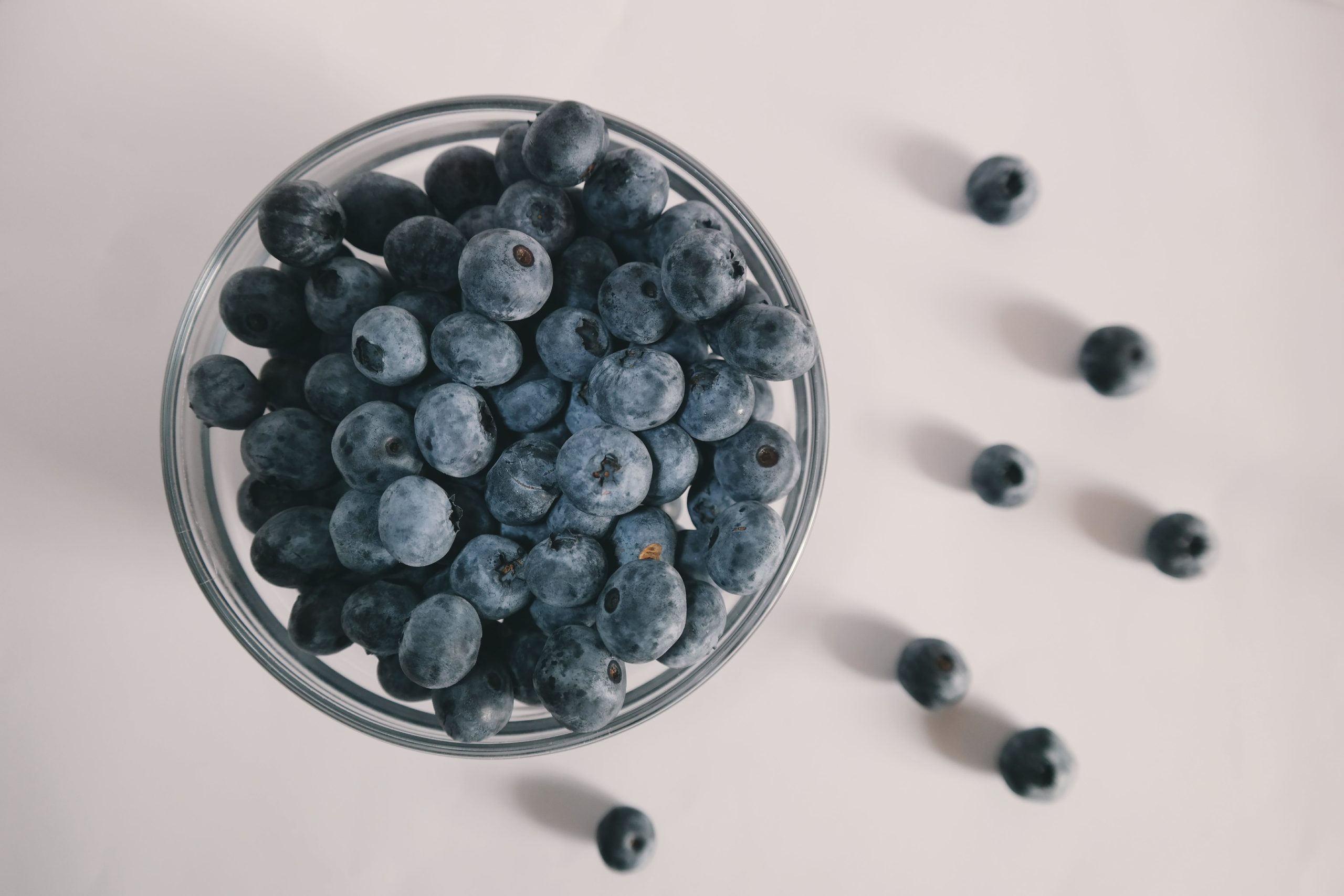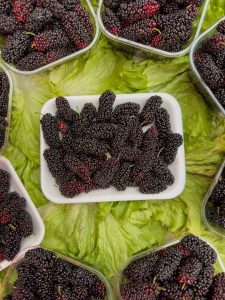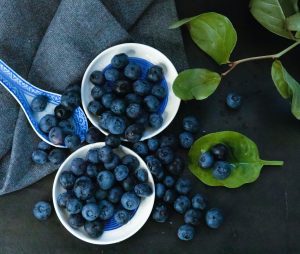
What Is a Blueberry?
A blueberry is a small, round, and sweet berry that belongs to the Vaccinium genus. These berries are known for their vibrant blue color, though some varieties can range from purple to black. Blueberries are native to North America but are now widely cultivated in various regions globally. They grow on shrubs and are a popular fruit due to their delicious taste and numerous health benefits.
Blueberries are rich in antioxidants, vitamins, and fiber, making them a nutritious addition to diets. They are commonly consumed fresh, added to salads, cereals, or baked into various dishes such as muffins, pancakes, and pies. Additionally, blueberries have been linked to potential health benefits, including improved cognitive function and heart health. The versatility, nutritional value, and delightful flavor make blueberries a popular choice in both culinary and nutritional contexts.
Why Do We Eat Blueberries?
People eat blueberries for various reasons, primarily due to their appealing taste and numerous health benefits. Here are some reasons why blueberries are commonly included in diets:
- Nutrient-rich:
- Blueberries are packed with essential nutrients, including vitamins C and K, manganese, and antioxidants. These nutrients contribute to overall health and well-being.
- Antioxidant properties:
- Blueberries are known for their high levels of antioxidants, such as anthocyanins, which help combat oxidative stress in the body. Antioxidants play a role in reducing inflammation and protecting cells from damage.
- Heart health:
- The compounds in blueberries have been associated with improvements in heart health. They may help lower blood pressure, reduce cholesterol levels, and support overall cardiovascular function.
- Cognitive benefits:
- Some studies suggest that the antioxidants in blueberries may have positive effects on cognitive function, potentially improving memory and reducing the risk of age-related cognitive decline.
- Weight management:
- Blueberries are low in calories and high in fiber, making them a satisfying and nutritious snack that can contribute to weight management and digestive health.
- Versatility in cooking:
- Blueberries can be incorporated into a variety of dishes, from breakfast options like cereals and yogurt to baked goods like muffins and pies. Their versatility makes them a popular and tasty ingredient in many recipes.
Overall, the combination of delicious flavor and health-promoting properties makes blueberries a popular and nutritious choice in many diets.
When Do We Eat Blueberries?
Blueberries can be enjoyed at various times of the day and incorporated into a wide range of meals. Here are some common occasions and ways people consume blueberries:
- Breakfast:
- Add fresh or frozen blueberries to cereal, oatmeal, yogurt, or smoothies for a flavorful and nutritious start to the day.
- Snacking:
- Blueberries make for a convenient and healthy snack. They can be eaten on their own or combined with nuts for a satisfying snack.
- Baking:
- Blueberries are often used in baking, such as in muffins, pancakes, waffles, or scones. Their sweet and tart flavor enhances the taste of various baked goods.
- Salads:
- Toss blueberries into salads for a burst of sweetness and color. They pair well with greens, feta cheese, and nuts.
- Desserts:
- Blueberries are commonly used in desserts like pies, cobblers, crisps, and ice creams. Their natural sweetness and vibrant color contribute to the appeal of these treats.
- Entrees:
- Blueberries can also be included in savory dishes. They pair well with meats like chicken or pork and can be used to create flavorful sauces or glazes.
- Beverages:
- Blueberries can be used to flavor water, lemonade, or iced tea. They are also popular in smoothies and can be blended with other fruits and ingredients for a refreshing beverage.
The versatility of blueberries allows them to be enjoyed in a variety of ways, making them a flexible and tasty addition to meals and snacks throughout the day.
Ingredients of Blueberries
The primary components of blueberries are water, carbohydrates, fiber, and various vitamins and minerals. Here’s a breakdown of the main nutritional components found in blueberries:
- Water:
- Blueberries have a high water content, which contributes to their juiciness and refreshing taste.
- Carbohydrates:
- Blueberries are a good source of carbohydrates, providing natural sugars such as glucose, fructose, and sucrose. They contribute to the sweet flavor of the fruit.
- Dietary Fiber:
- Blueberries are rich in dietary fiber, which promotes digestive health. Fiber also helps in maintaining a feeling of fullness and can assist with weight management.
- Vitamins:
- Blueberries contain various vitamins, with vitamin C being one of the most prominent. Vitamin C is an antioxidant that supports the immune system and helps the body absorb iron.
- Minerals:
- Blueberries contain minerals such as manganese, which plays a role in bone formation and metabolism.
- Antioxidants:
- Blueberries are known for their high antioxidant content, particularly anthocyanins. These compounds have been linked to various health benefits, including reducing oxidative stress and inflammation in the body.
- Phytochemicals:
- Blueberries contain phytochemicals, which are naturally occurring compounds that may have health-promoting properties.
It’s important to note that the nutritional content can vary slightly based on factors such as the variety of blueberries, growing conditions, and ripeness. Blueberries are a nutritious and flavorful addition to a well-balanced diet, offering a range of health benefits.
Types of Blueberries
There are several types of blueberries, each with its own unique characteristics, flavor profiles, and growing preferences. Blueberries are often categorized into three main types: highbush, lowbush, and hybrid half-high. Here’s a brief overview of each:
Highbush Blueberries:
- Vaccinium corymbosum:
- Highbush blueberries are the most common type and are often found in grocery stores. They are cultivated varieties with larger berries and a sweet flavor. Varieties include ‘Bluecrop,’ ‘Duke,’ ‘Jersey,’ and ‘Elliot.’
Lowbush Blueberries:
- Vaccinium angustifolium:
- Lowbush blueberries are smaller and often have a more intense flavor compared to highbush varieties. They are native to North America and are commonly found in the wild. Varieties include ‘Wild Blue,’ ‘Tophat,’ and ‘Northblue.’
Hybrid Half-High Blueberries:
- These blueberries are a cross between highbush and lowbush varieties, combining the best characteristics of both. They are often more compact and cold-hardy than highbush blueberries. Varieties include ‘Northsky’ and ‘Northcountry.’
Rabbiteye Blueberries:
- Vaccinium virgatum:
- Rabbiteye blueberries are native to the southeastern United States and are well-suited to warmer climates. They tend to have a slightly tart flavor. Varieties include ‘Climax,’ ‘Premier,’ and ‘Tifblue.’
Southern Highbush Blueberries:
- These are hybrids developed to thrive in the southern United States, combining the characteristics of highbush and Rabbiteye varieties. Varieties include ‘Sharpblue’ and ‘Misty.’
It’s important to choose blueberry varieties that are well-suited to your climate and growing conditions for successful cultivation. The specific flavor, size, and other characteristics can vary among different blueberry types and varieties.
Signs of Ripe, Signs of Raw and Signs of Rotten Blueberries
Recognizing the ripeness, freshness, and potential spoilage of blueberries involves paying attention to various sensory and visual cues. Here are signs to help you distinguish between ripe, raw, and potentially rotten blueberries:
Signs of Ripe Blueberries:
- Color:
- Ripe blueberries typically have a deep, uniform blue or purple color. Depending on the variety, they may also have a slight silvery bloom.
- Firmness:
- Ripe blueberries should be plump, round, and firm to the touch. Gently squeeze a few berries to assess their firmness.
- Texture:
- Ripe blueberries have a smooth and taut skin. Avoid berries that appear wrinkled or shriveled.
- Sweet Aroma:
- Ripe blueberries often emit a sweet, fruity aroma. Smell the container or package to check for this pleasant fragrance.
Signs of Raw Blueberries:
- Color:
- Raw blueberries are typically lighter in color, often greenish or reddish. As they ripen, they will gradually turn blue or purple.
- Firmness:
- Raw blueberries may feel slightly firmer than ripe ones. They can be tart or less sweet compared to fully ripened berries.
- Taste:
- Raw blueberries may have a more tangy or less sweet taste compared to fully ripe ones.
Signs of Rotten Blueberries:
- Mold:
- Check for any visible signs of mold on the surface of the berries. Discard blueberries with mold, as it can spread quickly.
- Off Odors:
- Rotten blueberries may have an unpleasant or fermented odor. If the berries smell off or sour, they may be spoiled.
- Wrinkling:
- Berries that have started to wrinkle or appear shriveled are likely overripe or beginning to spoil.
- Softness:
- Rotten blueberries may feel excessively soft or mushy. Gently press on the berries to assess their texture.
- Unusual Colors:
- Berries with unusual colors, such as brown or black spots, may be a sign of decay or spoilage.
When selecting blueberries, choose those that are plump, firm, and have a vibrant color. Inspect the container for any signs of mold or off odors. Proper storage in the refrigerator can help prolong the freshness of ripe blueberries.
Summary
Blueberries are small, round berries belonging to the Vaccinium genus, primarily known for their vibrant blue color and sweet, juicy flavor. There are different types of blueberries, including highbush, lowbush, hybrid half-high, rabbiteye, and southern highbush varieties, each with unique characteristics and growing preferences. They are commonly enjoyed for various reasons:
- Nutritional Benefits:
- Blueberries are rich in essential nutrients, including vitamins C and K, manganese, and antioxidants. They contribute to overall health and well-being.
- Antioxidant Properties:
- Blueberries are known for their high levels of antioxidants, particularly anthocyanins, which help combat oxidative stress and inflammation in the body.
- Health Benefits:
- Consumption of blueberries has been linked to potential health benefits, such as improved heart health, cognitive function, and weight management.
- Versatility in Cooking:
- Blueberries are versatile and can be incorporated into a variety of dishes, including breakfast items, salads, desserts, and beverages. They are commonly used in baking, such as muffins, pies, and pancakes.
- Types of Blueberries:
- Different types of blueberries offer distinct flavors and characteristics. Highbush, lowbush, hybrid half-high, rabbiteye, and southern highbush varieties cater to diverse climates and preferences.
When selecting blueberries, look for plump, firm berries with a deep blue or purple color. Ripe blueberries emit a sweet aroma and have smooth, taut skins. Avoid berries with mold, off odors, or signs of rotting. Proper storage in the refrigerator can help maintain their freshness. Whether enjoyed fresh, frozen, or in various culinary creations, blueberries remain a popular and nutritious fruit.






